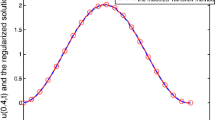Abstract
A numerical model of nonlinear two-dimensional steady inverse heat conduction problem was established considering the thermal conductivity changing with temperature. Combining the chaos optimization algorithm with the gradient regularization method, a chaos-regularization hybrid algorithm was proposed to solve the established numerical model. The hybrid algorithm can give attention to both the advantages of chaotic optimization algorithm and those of gradient regularization method. The chaos optimization algorithm was used to help the gradient regularization method to escape from local optima in the hybrid algorithm. Under the assumption of temperature-dependent thermal conductivity changing with temperature in linear rule, the thermal conductivity and the linear rule were estimated by using the present method with the aid of boundary temperature measurements. Numerical simulation results show that good estimation on the thermal conductivity and the linear function can be obtained with arbitrary initial guess values, and that the present hybrid algorithm is much more efficient than conventional genetic algorithm and chaos optimization algorithm.
Similar content being viewed by others
References
Stolz G J. Numerical solution to an inverse problem of heat conduction for simple shapes[J].Journal of Heat Transfer, 1960,82C(1):20–26.
YU Chang-ming. The inverse problem of heat conduction in calculation of the properties[J].Journal of Engineering Thermophysics, 1982,3(4):372–378. (in Chinese)
Kohn R, Vogelins M. Determining conductivity by boundary measurements[J].Communications on Pure and Applied Mathematics, 1984,37(3):289–298.
Tervola P. A method to determine the thermal conductivity from measured temperature profiles[J].International Journal of Heat and Mass Transfer, 1989,32(8):1425–1430.
Lin J Y, Cheng T F. Numerical estimation of thermal conductivity from boundary temperature measurements[J].Numerical Heat Transfer, 1997,32A(2):187–203.
Garcia S, Guynn J, Scott E P. Use of genetic algorithms in thermal property estimation Part II: simultaneous estimation of thermal properties[J].Numerical Heat Transfer, 1998,33A(2):149–168.
BAI Bo-feng, GUO Lie-jin, CHEN Xue-jun. A solution of multi-dimensional transient inverse heat conduction problem using the least square method[J].Chinese Journal of Computational Physics, 1997,14(4–5):696–698. (in Chinese)
WANG Deng-gang, LIU Ying-xi, LI Shou-ju. Two dimensional numerical solution for nonlinear inverse steady heat conduction[J].Journal of Xi'an Jiaotong University, 2000,34(11):49–52. (in Chinese)
HUANG Guang-yuang, LIU Xiao-jun.Inverse Problems in Mathematical Physics[M]. Jinan: Shandong Science & Technology Press, 1993, 57–61. (in Chinese)
Tikhonov A N, Arsenin V Y.Solutions of Ill-Posed Problems[M]. Fritz John Transl. Washington: Winston Press, 1977. (English version)
TANG Li-min, ZHANG Wen-fei, LIU Ying-xi. Gradient regularization method to solve the inverse problems for differential equation[J].Computational Structural Mechanics and Applications, 1991,8(2):123–129. (in Chinese)
LIU Ying-xi, WANG Deng-gang, ZHANG Jia-liang, et al. Identifying material parameters with gradient regularization method[J].Journal of Computational Mechanics, 2000,17(1):69–75. (in Chinese)
WANG Deng-gang, LIU Ying-xi, LI Shou-ju, et al. Regularization produre for two-dimensional inverse heat conduction problem[J].Acta Scientiarum Naturalium Universitatis Jilinensis, 2000, (2):56–60. (in Chinese)
WANG Dong-sheng, CHAO Lei.Chaos Fractal and Their Applications[M]. Hefei: China University of Science & Technology Press, 1995, 25–92. (in Chinese)
LI Bing, JIANG Wei-sun. Chaos optimization method and its applications[J].Control Theory and Applications, 1997,14(4):613–615. (in Chinese)
KONG Xiang-qian.The Finite Element in Heat Transfer (2nd edition) [M]. Beijing: Science Press, 1986, 148–150. (in Chinese)
YANG Wen-cai.Geophysical Inversion & Seismic Tomography[M]. Beijing: Geologic Press, 1989, 117–119. (in Chinese)
Author information
Authors and Affiliations
Additional information
Communicated by TANG Li-min
Foundation item: the National Natural Science Foundation of China (10072014)
Biography: WANG Deng-gang (1970−)
Rights and permissions
About this article
Cite this article
Deng-gang, W., Ying-xi, L. & Shou-ju, L. Chaos-regularization hybrid algorithm for nonlinear two-dimensional inverse heat conduction problem. Appl Math Mech 23, 973–980 (2002). https://doi.org/10.1007/BF02437803
Received:
Revised:
Issue Date:
DOI: https://doi.org/10.1007/BF02437803
Key words
- inverse problem
- inverse heat conduction problem
- thermal conductivity
- global optimum
- hybrid algorithm
- chaos optimization algorithm
- gradient regularization method




